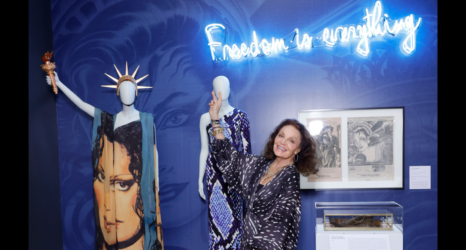In the heart of the Brooklyn Museum, between Picasso’s “Woman in Gray” and Monet’s rippled river in “Islets at Port-Villez,” landmark women from many fields traded stories on a Thursday night this October. Kathy Kusner, the first female jockey in the United States talked with Jodi Archambault Gillette, the first Special Assistant to the President for Native American Affairs. Artist Judy Chicago clinked glasses with the authors of the textbook Our Bodies, Ourselves.
The women gathered there were honorees at the annual Sackler Center First Awards, which mark milestone careers in art, culture and society. Just one floor above them marked another trailblazing achievement: the first center for feminist art.
“It’s important to celebrate milestones,” said Ms. co-founder Gloria Steinem, who was on-hand to distribute awards, “because they inspire the future both by reminding us of past barriers and the women who broke them, and in encouraging us to break through those that still exist. There is a saying: if you can’t see it, you can’t be it. Witnessing bravery and innovation in the past creates bravery and innovation in the future.”
Elizabeth Sackler, founder of the Sackler Center for Feminist Art, agreed. “We need to learn our herstory first and celebrate milestones simultaneously,” she told attendees, “and, without pause, demand parity, demand our rights.”
During the ceremony, the crowd gave thunderous applause to Sackler First recipients as speakers voiced hope that it will be easier for future generations of women to advance in each field. For the honorees to achieve their work in athletics, journalism, architecture, painting and politics, they had to navigate through world where no woman had done it before. Thanks to them, that is no longer the case.
Special honoree Judy Chicago–who rocked hot pink hair, bright blue glasses and sneakers–set the night’s tone of joyful defiance. She told the audience that anger can absolutely fuel art, and how she sees her seminal piece, “The Dinner Party,” as a way of combatting erasure in history. “You cannot look around the world today and not recognize that erasure is alive and well,” Chicago said. Fusing feminism with china patterns, female anatomy and butterflies, the artist’s three-dimensional banquet is designed with places for everyone from Emily Dickinson to Georgia O’Keefe, Sojourner Truth to Virginia Wolf. (Susan B. Anthony gets a spot at the head of the table.)
Chicago’s “The Dinner Party” has been a staple of the Brooklyn Museum for years. What makes this season different is the complimentary exhibition “Roots of ‘The Dinner Party’: History in the Making” which leads up to it. Chronicling Chicago’s artistic process, the roots exhibit examines her study of china painting and the role other artists had in helping her assemble and complete the table. On stage, Chicago acknowledged her brigade of collaborators including men who believed in her work and vision. “Achievement doesn’t happen in a vacuum,” Chicago said. “It happens in network of support. Without support the best idea doesn’t get realized.”
Collaboration continued to be a theme throughout the night. Loved ones and colleagues of LGBT marriage activist Edie Winsor were on-hand to receive her posthumous award. Gloria Steinem presented with palpable admiration. “Edie Winsor allowed her private life to become public,” Steinem said, “all the way up to the Supreme Court—so that millions of others would have a legally protected right to the private life of their choice.”
Another highlight came as the 12 authors of Our Bodies, Ourselves took the stage. The women, who are long-term collaborators, were given a standing ovation for making scientific data available to the public. Like Chicago, who cited her community in Los Angeles as an asset, the Our Bodies, Ourselves team found community in Boston, which welcomed their work as activists and academics. With articles ranging from puberty to menopause, they have devoted their lives to de-mystifying the female body and helping women combat shame.
While themes of celebration and achievement anchored the evening, it was clear that work remains. No amount of Picasso paintings and soft lighting could make the audience forget that they were days into the #MeToo hashtag and a year into the presidency of Donald Trump. That weekend, the museum would host the Brooklyn Conference with workshops and panels for social change including presentations from Sackler First honorees and organizers of the Women’s March on Washington. The Elizabeth A. Sackler Foundation was already presenting “States of Denial: The Illegal Incarceration of Women, Children, and People of Color” and the Sackler Center for Feminist Art was planning its next exhibition: “Radical Women: Latin American Art 1960-85.”
There were projects to finish, more work to be done. Still, it felt important, necessary even, for women to take pride in progress and have a night where representatives of different disciplines could stand together. As the honorees accepted their awards, they reminded us that the world is malleable, something to be shaped—and that change is possible through deliberate individual action and collaboration.
Or, as Sackler says: when we pursue, persist and insist.





